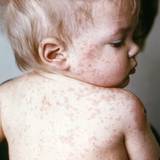Shop
02036
https://www.under5s.co.nz/shop/Hot+Topics+Articles/Health+%26+Wellbeing/Toddlers/Keeping+kids+safe+around+water.html
Keeping kids safe around water
|
Water play can be a great source of fun and exercise for the whole family, but it can also be dangerous for kids if the proper water safety precautions are not taken. The good news is though there are many ways to keep children safe in and around water. Check out these helpful tips.
|
You might also be interested in ...
Tips on starting night time toilet training
Thinking of night time toilet training? Once your child is out of nappies during the day, the next step is to start toilet training at night. Every child is different, so is the length of time it will take for them to be fully night time toilet trained will differ too. Just remember, it’s not a competition!
How to recognise measles in babies & kids
Would you recognise if your baby or kids had measles? We take a look at the symptoms of measles, treatment, preventing measles and how to get the MMR vaccine.
join usJoin us on social media for all our latest news. |
sign upSign up and receive our latest newsletters. |
|







The good news is though there are many ways to keep children safe in and around water.
6 Ways to keep kids safe around water
1. Supervision
Young kids need constant supervision around water. Whether the water is in a bucket, a paddling pool, a fish pond, a swimming pool, a spa, the beach or a lake.
Young children are especially vulnerable - they can drown in less than 6 centimetres of water.
2. Swimming lessons
It’s never too early to begin swimming lessons to teach your kids how to swim.
3. Life jackets/life vests
Invest in proper fitting, coast guard approved flotation devices (life jackets/life vests) and use them whenever your kids are near water.
Check the weight and size recommendations on the label, then have your kids try theirs on to make sure it fits snugly.
For kids younger than 5 years old, choose a life jacket with a strap between the legs and head support - the collar will keep their head up and face out of the water.
Inflatable vests and arm devices such as water wings are not effective protection against drowning.
4. Protection
Teach your kids to be Sunsmart. Don't forget the sunscreen and reapply frequently, especially if the children are getting wet. UV sunglasses, hats, and protective clothing can also help provide sun protection.
5. Stay hydrated
Kids should drink plenty of fluids, particularly water, to prevent dehydration. It's easy to get dehydrated in the sun, especially when kids are active and sweating.
Dizziness, feeling lightheaded, or nausea are just some of the signs of dehydration and overheating.
6. Fence in your pool
Having a fence (one that goes directly around the pool or spa) between the water and your house is the best safety investment you can make and will help prevent pool-related drownings.
Check with your local council regarding requirements for this.
Tell your friends
Like the article you've just been reading? Click on the Refer A Friend link at the top of the page and send the details to friends who might like to read it too.More Hot Topics for you to enjoy
Source: This article was written by Nurtured At Home - providing high quality learning environments in a safe and nurturing home.
Image source: brisbanekids.com.au